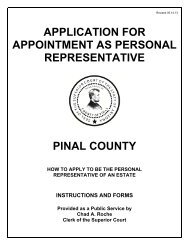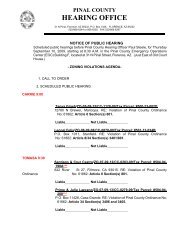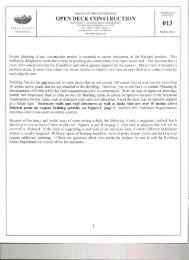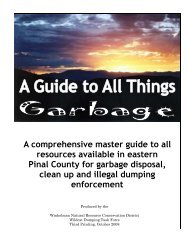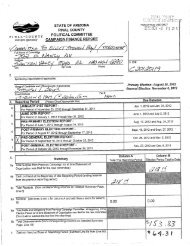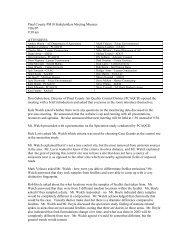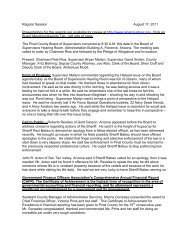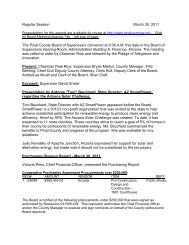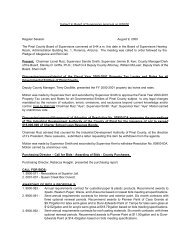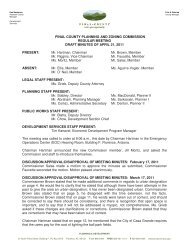Wood Burning Handbook - Pinal County
Wood Burning Handbook - Pinal County
Wood Burning Handbook - Pinal County
Create successful ePaper yourself
Turn your PDF publications into a flip-book with our unique Google optimized e-Paper software.
Most Fireplaces are Not Good<br />
Heaters!<br />
Most fireplaces rob your house of heat because they draw<br />
air from the room and send it up the chimney! Yes, you'll be<br />
warmed if you sit within six feet of the fire, but the rest of<br />
your house is getting colder as outdoor air leaks in to replace<br />
the hot air going up the chimney.<br />
The key to burning clean and hot is to control the airflow.<br />
Most fireplaces waste wood because of unrestricted airflow.<br />
A lot of air helps the fire burn fast, but a load of wood will<br />
last only one or two hours.<br />
Some older fireplaces actually pollute more if you install<br />
glass doors on an old fireplace insert that is not a certified<br />
clean-burning model. Restricting the air supply causes the<br />
fire to smolder and smoke. Make sure you install a new,<br />
certified clean-burning fireplace insert.<br />
Where Does Your Heat Go?<br />
Check your Insulation and Weather-Stripping<br />
Warm air is always escaping from your house, and is replaced by unheated outdoor air. The typical<br />
house has one-half to two air exchanges per hour, and more on windy and/or very cold days. If your<br />
house has little insulation and many air leaks, you are paying to heat the outdoors. And if the outside<br />
air is smoky, soon your air inside will be too.<br />
Some air exchange is necessary because of the many sources of air pollution in the home (wood heater,<br />
gas stove, consumer products, cigarettes, etc.) Sufficient fresh air inlets are needed to replace air forced<br />
out of the house by exhaust fans, dryers, furnaces, water heaters, or wood fires.<br />
Here are some suggestions to minimize excess air exchange:<br />
Install Ceiling Insulation. When hot air rises, much of the heat is lost through the ceiling and roof. Wall<br />
and floor insulation also reduce heat loss. Recommended amounts of insulation have increased in recent<br />
years, so be sure your house has all it needs.<br />
Caulk around all windows, doors, pipes, and any opening into the<br />
house.<br />
Weather-strip all door and window openings. Consider installing<br />
double-paned glass, outdoor or indoor storm windows, and/or insulated<br />
curtains.<br />
Close the damper tightly when the heater is not in use. Stoves<br />
and fireplaces allow air to leak out of the house even when they are<br />
not operating, unless they are literally airtight.<br />
Close off unused rooms if you do not use central heating –<br />
Don’t waste the heat!<br />
6



